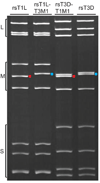An improved reverse genetics system for mammalian orthoreoviruses
- PMID: 20042210
- PMCID: PMC2823833
- DOI: 10.1016/j.virol.2009.11.037
An improved reverse genetics system for mammalian orthoreoviruses
Abstract
Mammalian orthoreoviruses (reoviruses) are highly useful models for studies of double-stranded RNA virus replication and pathogenesis. We previously developed a strategy to recover prototype reovirus strain T3D from cloned cDNAs transfected into murine L929 fibroblast cells. Here, we report the development of a second-generation reovirus reverse genetics system featuring several major improvements: (1) the capacity to rescue prototype reovirus strain T1L, (2) reduction of required plasmids from 10 to 4, and (3) isolation of recombinant viruses following transfection of baby hamster kidney cells engineered to express bacteriophage T7 RNA polymerase. The efficiency of virus rescue using the 4-plasmid strategy was substantially increased in comparison to the original 10-plasmid system. We observed full compatibility of T1L and T3D rescue vectors when intermixed to produce a panel of T1LxT3D monoreassortant viruses. Improvements to the reovirus reverse genetics system enhance its applicability for studies of reovirus biology and clinical use.
Copyright 2009 Elsevier Inc. All rights reserved.
Figures





Similar articles
-
Reverse genetics for mammalian reovirus.Methods. 2011 Oct;55(2):109-13. doi: 10.1016/j.ymeth.2011.07.002. Epub 2011 Jul 21. Methods. 2011. PMID: 21798351 Free PMC article.
-
A plasmid-based reverse genetics system for mammalian orthoreoviruses driven by a plasmid-encoded T7 RNA polymerase.J Virol Methods. 2014 Feb;196:36-9. doi: 10.1016/j.jviromet.2013.10.023. Epub 2013 Oct 29. J Virol Methods. 2014. PMID: 24183920 Free PMC article.
-
Silencing and complementation of reovirus core protein mu2: functional correlations with mu2-microtubule association and differences between virus- and plasmid-derived mu2.Virology. 2007 Aug 1;364(2):301-16. doi: 10.1016/j.virol.2007.03.037. Epub 2007 Apr 23. Virology. 2007. PMID: 17451769 Free PMC article.
-
Modification of mammalian reoviruses for use as oncolytic agents.Expert Opin Biol Ther. 2009 Dec;9(12):1509-20. doi: 10.1517/14712590903307370. Expert Opin Biol Ther. 2009. PMID: 19916732 Review.
-
[Orthoreoviruses].Uirusu. 2014;64(2):191-202. doi: 10.2222/jsv.64.191. Uirusu. 2014. PMID: 26437841 Review. Japanese.
Cited by
-
Viral gene expression potentiates reovirus-induced necrosis.Virology. 2015 Oct;484:386-394. doi: 10.1016/j.virol.2015.06.018. Epub 2015 Jul 28. Virology. 2015. PMID: 26226583 Free PMC article.
-
Lipid Membranes Facilitate Conformational Changes Required for Reovirus Cell Entry.J Virol. 2015 Dec 23;90(5):2628-38. doi: 10.1128/JVI.02997-15. J Virol. 2015. PMID: 26699639 Free PMC article.
-
Glycan engagement dictates hydrocephalus induction by serotype 1 reovirus.mBio. 2015 Mar 3;6(2):e02356. doi: 10.1128/mBio.02356-14. mBio. 2015. PMID: 25736887 Free PMC article.
-
Establishment of different plasmid only-based reverse genetics systems for the recovery of African horse sickness virus.Virology. 2016 Dec;499:144-155. doi: 10.1016/j.virol.2016.07.010. Epub 2016 Sep 19. Virology. 2016. PMID: 27657835 Free PMC article.
-
A post-entry step in the mammalian orthoreovirus replication cycle is a determinant of cell tropism.J Biol Chem. 2010 Dec 31;285(53):41604-13. doi: 10.1074/jbc.M110.176255. Epub 2010 Oct 26. J Biol Chem. 2010. PMID: 20978124 Free PMC article.
References
-
- Barton ES, Connolly JL, Forrest JC, Chappell JD, Dermody TS. Utilization of sialic acid as a coreceptor enhances reovirus attachment by multistep adhesion strengthening. Journal of Biological Chemistry. 2001;276:2200–2211. - PubMed
Publication types
MeSH terms
Substances
Grants and funding
LinkOut - more resources
Full Text Sources
Other Literature Sources
Research Materials

